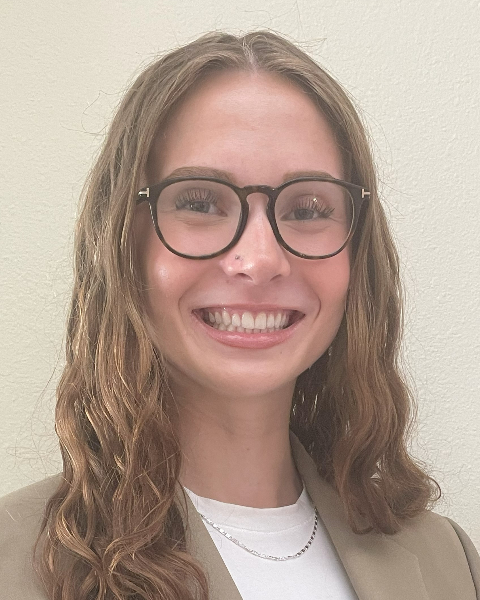PQA 07 - PQA 07 Gastrointestinal Cancer and Sarcoma/Cutaneous Tumors Poster Q&A
2987 - Outcomes Based on Surgical Timing after Neoadjuvant Therapy for Locally Advanced Esophageal Cancer
Tuesday, October 1, 2024
12:45 PM - 2:00 PM ET
Location: Hall C
Screen: 9

Sarah Goodchild, BS, BA
Moffitt Cancer Center
Tampa, FL
Presenter(s)
S. A. Goodchild1, J. M. Frakes2, R. F. Palm3, S. Hoffe2, S. Saeed1, R. Mehta1, J. Fontaine4, A. Sinnamon1, and J. Pimiento5; 1Moffitt Cancer Center, Tampa, FL, 2H. Lee Moffitt Cancer Center and Research Institute, Department of Radiation Oncology, Tampa, FL, 3University of Toledo Medical Center, Toledo, OH, 4H. Lee Moffitt Cancer Center and Research Institute, Tampa, FL, 5H. Lee Moffitt Cancer Center and Research Institute, Department of Surgical Oncology, Tampa, FL
Purpose/Objective(s): Esophageal cancer (EC) is the eighth most common cancer worldwide, with a low 5-year survival rate1,2. The current standard of care for locoregional disease includes neoadjuvant chemoradiation (NAT) followed by surgical resection. However in consideration of the preliminary results of the SANO trial, the optimal time for surgical therapy has not been defined. The primary aim of this study was to assess clinical outcomes including pathologic complete response rate based on the interval between completion of NAT and surgery to infer the optimal time to assess for clinical complete response to NAT. Materials/
Methods: We conducted an IRB approved single center retrospective review of a prospectively maintained esophagectomy database. The study population was EC patients who completed NAT and underwent esophageal surgery. Patients were grouped into one of six cohorts (1-4 weeks (C1), 4-8 weeks (C2), 8-12 weeks (C3), 12 weeks - 6 months (C4), 6 months to 1 year (C5), or >1 year(C6)). The primary endpoint was pathologic response as follows: complete response (pCR) partial response pPR, no response (pNR), survival from time of surgery and complication rate. Descriptive statistics and Kaplan-Meier analysis for overall survival (OS) were performed.
Results: Of the total number (1340) of patients, 880 fulfilled the inclusion criteria. The median age was 64.3 years. 83.9% were male, and 93.5% white. C1, C2, C3, C4, C5 and C6 respectively included 16, 237, 379, 177, 31, and 30 patients. pCR was highest for group C3 and C4 at 47% and was lower for C6 (p value = 0.001). Overall any postoperative complications were higher for C4 and C5 (70%), but were not statistically significant. Postoperative death was highest for C4 (8%) and C3 (3%; p = 0.008). Overall median OS was 42.5 months (34.9-50.0). Grouped by cohorts, median OS was 16.5 (8.5-24.5) for C1, 48.6 (30.6-66.7) for C2, 45.7 (35.7-55.7) for C3, 32.6 (16.39-49.0) for C4, 16.1 (.0-42.3) for C5, and 38.6 (6.4 -70.7) for C6 (p=0.043).
Conclusion: Our results indicate an increase in the rate of pCR after 8wks post NAT. The optimal time for surgery may be somewhere between 4-8wks based on complication rate and OS. However, delayed surgery if clinical complete response is a reasonable approach as it relates to complications and OS. Biases based on patient condition and surgeon assessment of patient fitness may significantly impact our results.
Purpose/Objective(s): Esophageal cancer (EC) is the eighth most common cancer worldwide, with a low 5-year survival rate1,2. The current standard of care for locoregional disease includes neoadjuvant chemoradiation (NAT) followed by surgical resection. However in consideration of the preliminary results of the SANO trial, the optimal time for surgical therapy has not been defined. The primary aim of this study was to assess clinical outcomes including pathologic complete response rate based on the interval between completion of NAT and surgery to infer the optimal time to assess for clinical complete response to NAT. Materials/
Methods: We conducted an IRB approved single center retrospective review of a prospectively maintained esophagectomy database. The study population was EC patients who completed NAT and underwent esophageal surgery. Patients were grouped into one of six cohorts (1-4 weeks (C1), 4-8 weeks (C2), 8-12 weeks (C3), 12 weeks - 6 months (C4), 6 months to 1 year (C5), or >1 year(C6)). The primary endpoint was pathologic response as follows: complete response (pCR) partial response pPR, no response (pNR), survival from time of surgery and complication rate. Descriptive statistics and Kaplan-Meier analysis for overall survival (OS) were performed.
Results: Of the total number (1340) of patients, 880 fulfilled the inclusion criteria. The median age was 64.3 years. 83.9% were male, and 93.5% white. C1, C2, C3, C4, C5 and C6 respectively included 16, 237, 379, 177, 31, and 30 patients. pCR was highest for group C3 and C4 at 47% and was lower for C6 (p value = 0.001). Overall any postoperative complications were higher for C4 and C5 (70%), but were not statistically significant. Postoperative death was highest for C4 (8%) and C3 (3%; p = 0.008). Overall median OS was 42.5 months (34.9-50.0). Grouped by cohorts, median OS was 16.5 (8.5-24.5) for C1, 48.6 (30.6-66.7) for C2, 45.7 (35.7-55.7) for C3, 32.6 (16.39-49.0) for C4, 16.1 (.0-42.3) for C5, and 38.6 (6.4 -70.7) for C6 (p=0.043).
Conclusion: Our results indicate an increase in the rate of pCR after 8wks post NAT. The optimal time for surgery may be somewhere between 4-8wks based on complication rate and OS. However, delayed surgery if clinical complete response is a reasonable approach as it relates to complications and OS. Biases based on patient condition and surgeon assessment of patient fitness may significantly impact our results.
